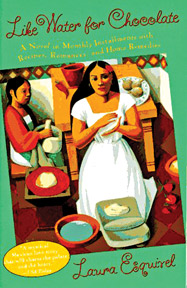Como agua para chocolate
 Last week I reviewed 'El Beso de la mujer arana' and discussed how
Latin American authors who began to write following the period known as
the 'Boom' used popular writing to engage with political and social
issues in a way that was accessible to the masses. Laura Esquivel's
first novel, 'Como agua para chocolate' is an outstanding example of
such, having been translated into 30 languages. Last week I reviewed 'El Beso de la mujer arana' and discussed how
Latin American authors who began to write following the period known as
the 'Boom' used popular writing to engage with political and social
issues in a way that was accessible to the masses. Laura Esquivel's
first novel, 'Como agua para chocolate' is an outstanding example of
such, having been translated into 30 languages.
It won international acclaim and the Spanish language film based on
the novel won eleven awards from the Mexican Academy of Motion Pictures.
The English translation of the novel 'Like water for chocolate' and
sub-titled film were equally successful in the United States and the
film was the largest grossing foreign film ever.
The novel's title phrase "Como agua para chocolate" refers to the
fact that water must be brought to the brink of boiling several times
before it is ready to be used for hot chocolate. Heat is a symbol for
desire and physical love throughout the novel. It is also clear early on
in the narrative that the title is a euphemism for sexual desire "She
turned her head, and her eyes met Pedro's. Tita knew perfectly well how
dough feels when it is plunged into boiling oil.
 |
|
Laura Esquivel |
The heat that invaded her body was so real she was afraid she would
start to bubble, her face, her stomach, her heart, her breasts" like
batter, and unable to endure his gaze she lowered her eyes and hastily
crossed the room".
The title of the novel is also a reference to the suppressed rage of
one of the two main characters, Tita De la Garza who has spent her whole
life tyrannised by her mother, Mama Elena; in Mexico a person said to be
boiling over with rage is described as being 'Like water for chocolate'.
The narrator is Tita's great-niece and the story is set in northern
Mexico during the early 1900s. The novel's 12 chapters, written one per
month in diary/instalment form relate details from over two decades of
Tita's life, beginning in 1910 when she is fifteen years old and ending
with her death at thirty-nine. Each chapter includes a recipe that Tita
prepares for her family during this period.
After her mother refuses to allow her to marry Pedro, the man she
loves, Tita channels her frustrated desires into the creation of
delicious meals that often have strange, magical effects on her family.
The novel is typical of the post-Boom genre of writing, as the magical
realist episodes are intrinsic to the development of the story, which is
at the same time rooted in real Mexican society in 1910.
The story of intense domestic tension makes the family itself a
microcosm for the political tensions at the time of the Mexican
Revolution.
The domestic struggle begins when Tita and Pedro fall in love as
children. When he is of age, Pedro and his father come to ask if Pedro
can have Tita's hand in marriage but Mama Elena refuses. The de la Garza
family tradition demands that the youngest daughter remain unmarried to
take care of her mother until she dies. Mama Elena offers Pedro
Rosaura's hand instead since she is the eldest daughter.
To the dismay of his father, Pedro accepts simply to be closer to
Tita. When Tita finds an excuse to not attend Rosaura's engagement
party, Mama Elena forces Tita to prepare the wedding banquet as
punishment. Yet Tita puts all her desire for Pedro into the cooking and
as the wedding guests eat the cake, they are overcome by an
"Intoxication" which causes intense longing for their true love.
 |
 |
| Gertrudis (ClaudetteMaille) |
Mamaelena |
This is the first of the many magical realist episodes that are woven
into the fabric of the narrative and move the story forward. The wedding
ends with all the guests crying and vomiting into the river and even
Mama Elena unlocks a box holding a photograph of a man who is not her
late husband. After Rosaura and Pedro are married Tita spends all her
time in the kitchen, which is traditionally a 'woman's domain' and it is
there that Tita's rebellion against repression begins to express itself.
Gertrudis, Tita's other sister, elopes with a soldier involved in the
Revolution, which symbolises a desire for change in both domestic and
political spheres. When a rose given to her secretly by Pedro, Tita uses
it to vent her unexpressed passion through a pre-Hispanic recipe -
'Quail in Rose Petal Sauce'.
The meal serves as an aphrodisiac, arousing insatiable desire. When
the meal is complete, Gertrudis goes to prepare a shower to rid herself
of the pink sweat and rose-scented aroma she emits. The force of her
heat and passion, causes the water from the ranch shower to evaporate on
contact and eventually sets the structure on fire. Fleeing naked from
the burning shower, Gertrudis is scooped up naked onto a galloping horse
by Juan who was drawn by the intoxicating rose scent.
The passion overtly expressed by Gertrudis and Juan is representative
of Tita's own thwarted love and desire for Pedro. The disappearance of
Gertrudis reveals much about female sexuality in 'Como agua para
chocolate'. While Tita can only articulate her sexuality within the
domestic sphere, Gertrudis is able to exceed these boundaries without a
second thought.
Her flight can be seen as a triumph, wherein she sheds notions of
social propriety to pursue her unbridled desires. Conversely, her
departure from the ranch is also a sort of expulsion from 'decent
society'. The free expression of female desire clearly has no place in
the ordered domestic realm. The contrasting experiences of Gertrudis and
Tita illustrate the only two possibilities for female desire, both of
which are extremes: stifled and unarticulated or hypersexualized.
 |
|
LWFC |
Magical realism is used to provoke a sense of national identity
through popular culture by the use of Tita's mestizo cooking and the
physical reactions of those who consume her food. While this accentuates
the sexual, especially with Gertrudis' liberation from the hacienda,
Tita's violent attacks and ultimate revenge on Rosaura, who eventually
dies of 'serious digestive problems' following a spate of particularly
vicious rows between the sisters.
It also helps convey a sense of folklore and history within the
context of the Mexican Revolution using a family recipe book for
traditional Mexican dishes. The magical realist events brought about by
the food prepared from these recipes preface melodramatic events which
enable women's voices to be heard, both on a personal and collective
level. Therefore the narrative addresses and attempts to deal with both
feminist and political themes.
All female characters in 'Como agua para chocolate' are battling for
liberation in one way or other. This also includes Tita's tyrannical
mother Do a Elena, who herself represents both the oppressive
patriarchal system and the traditions which incarcerate Tita. However,
it transpires that Do a Elena was also frustrated by a loveless marriage
to Tita's father and that Gertrudis is the result of an affair with a
'Mulatto'.
This truth is revealed when Gertrudis and Juan have a 'Mulatto' baby,
since Juan threatens to leave Gertrudis for infidelity. This suggests
that in spite of her apparent, dramatic liberation from the repressive
environment of the hacienda, she has not escaped accepted social norms
and she and Juan have become conventional. This implies that even
following a revolution, life must return to 'normal' and that it is
perhaps retaining some traditions.
With most of the narrative temporarily set within the era of the
revolution, Laura Esquivel mostly limits the reader/viewer to events
occurring at the de la Garza hacienda.
The revolutionary activities affecting the Northern frontier during
the revolution are not intrinsic to this story, even when Gertrudis
returns to the hacienda with the troops. Issues of culture, race,
economic hierarchy and patriarchy are defined by the relationships
between individuals at the hacienda. While much of the brutality and
violence associated with the Mexican revolution is absent from the
narrative, the few instances of transgressive acts are used to establish
heroism and machismo, or to comment on US intervention in Mexico.
However, the relationship between the US and Mexico is very
romanticised, since the main medium used to present it is the character
Dr. John Brown, a local North American doctor, takes pity on Tita and
brings her to live in his house. He patiently nurses her back to health,
cares for her physical ailments, revives her broken spirit and offers to
marry her.
However when returns from a trip to the US, Tita confesses she has
had further relations with Pedro. John replies that he still wishes to
marry her but that she must decide for herself with whom she wishes to
spend her life. Tita decides not to marry him and to continue her affair
with Pedro, which causes her to be the subject of malicious gossip for
the rest of her life.
 |
|
Tita |
While on the surface 'Como agua para chocolate' appears to be a
progressive narrative that celebrates women's willingness to break from
tradition, a closer reading reveals that real change is stifled.
Feminine power is derived from the preparation of food and through
fulfilling other traditional roles such as marriage and motherhood but
it is essentially the masculine gaze and agency which determine the
course of the novel. Pedro's decision to marry Rosaura and the
implication that Tita will only find liberation and redemption through
marriage after Mama Elena's death are examples of this.
There is no possibility for Tita to define herself outside
traditional feminine roles. In creating the female-centered cast of
characters, Esquivel creates a world in which although men are
physically present only occasionally, the legacy of sexism and the
confinement of women to the domestic sphere persist. Esquivel does not
offer her readers the vision of Utopian sisterhood but an insight into
the way women are restricted by standards of societal propriety
perpetuated by other women. Although a medium for self-expression, the
culinary 'mestizo' culture that represents both femininity and Mexican
national identity, it still occurs within the context of traditional,
patriarchal structures.
This suggests that for woman and for Mexican society itself, which
has an identity so deeply rooted in tradition, true liberation is an
illusory ideal, yet one well worth striving for.
|

